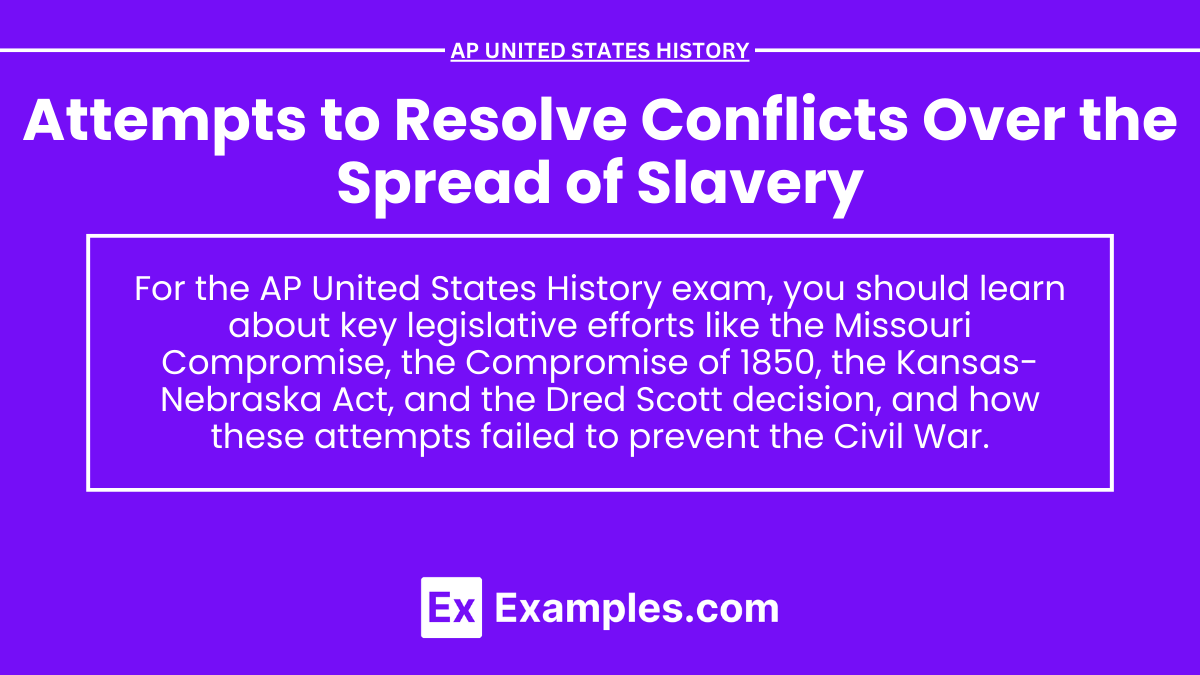In AP United States History, the attempts to resolve conflicts over the spread of slavery are a critical focus, as they highlight the deepening sectional divide between the North and South. From the Missouri Compromise of 1820 to the Kansas-Nebraska Act of 1854, various legislative efforts were made to balance the interests of free and slave states. Despite these efforts, the increasing tensions over slavery’s expansion ultimately proved insurmountable, leading the nation toward secession and the Civil War.
Learning Objectives
The learning objectives for the topic “Attempts to Resolve Conflicts Over the Spread of Slavery” will include the ability to analyze the various legislative efforts, such as the Missouri Compromise and the Compromise of 1850, aimed at addressing sectional tensions. You will be expected to evaluate the effectiveness of these compromises in managing the conflict between free and slave states, and understand how their failures contributed to the eventual outbreak of the Civil War.
Key Legislative Efforts
Missouri Compromise (1820)
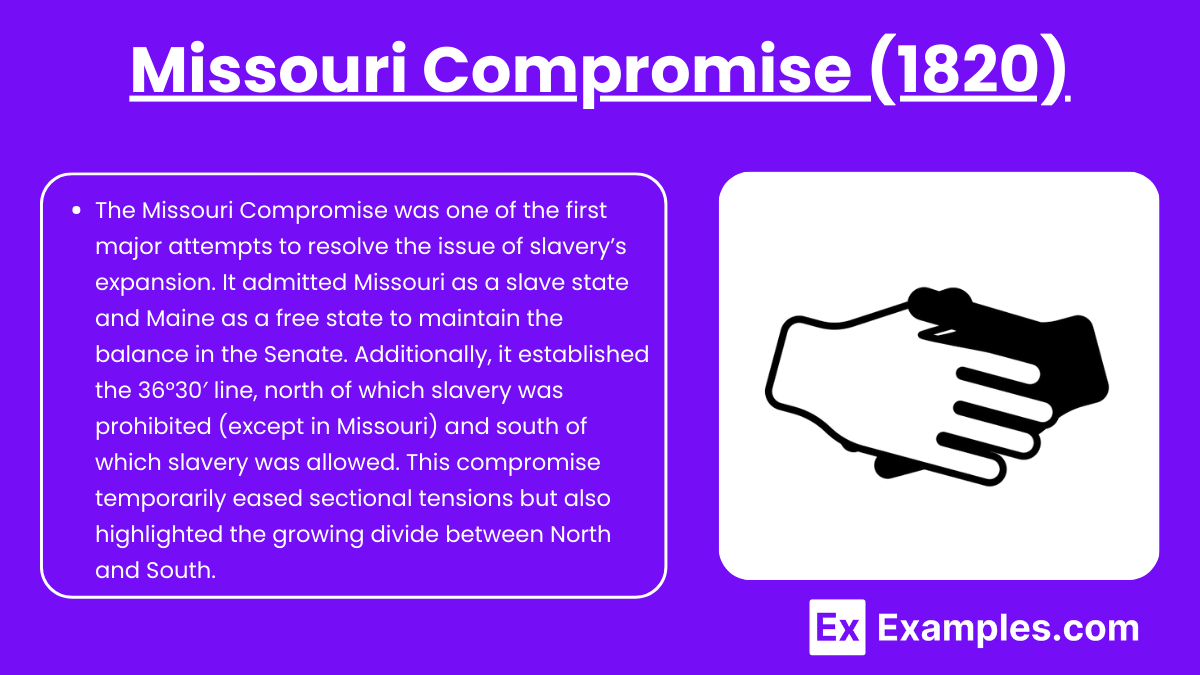
- The Missouri Compromise was one of the first major attempts to resolve the issue of slavery’s expansion. It admitted Missouri as a slave state and Maine as a free state to maintain the balance in the Senate. Additionally, it established the 36°30′ line, north of which slavery was prohibited (except in Missouri) and south of which slavery was allowed. This compromise temporarily eased sectional tensions but also highlighted the growing divide between North and South.
Wilmot Proviso (1846)
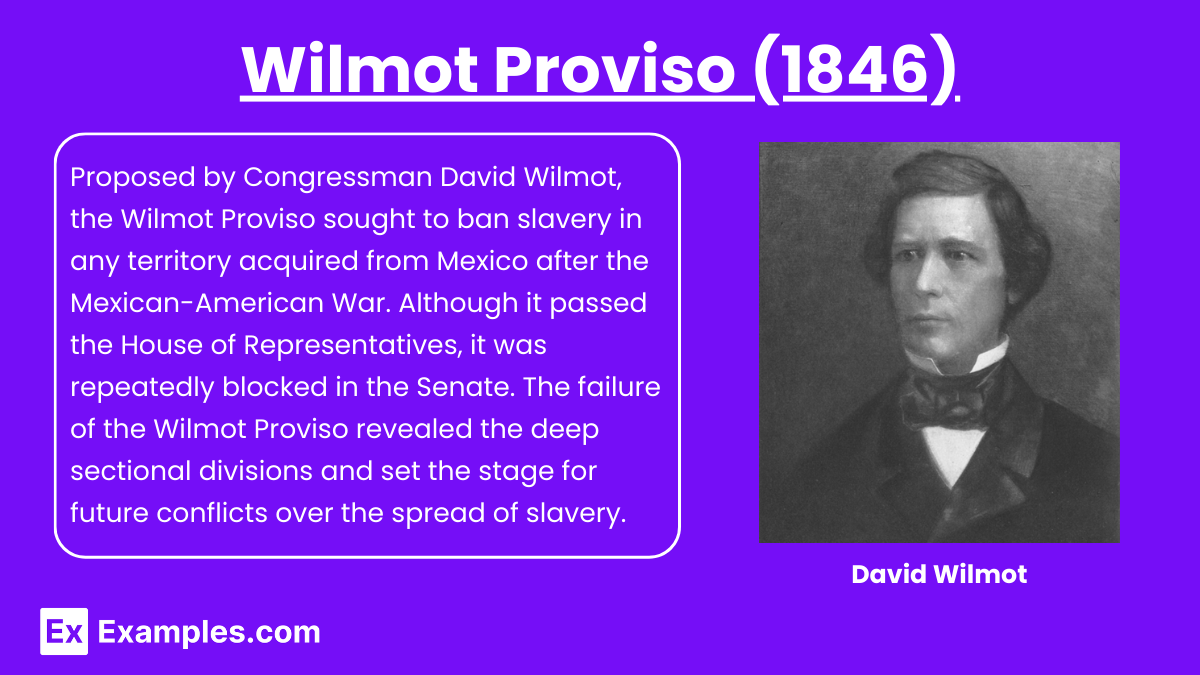
- Proposed by Congressman David Wilmot, the Wilmot Proviso sought to ban slavery in any territory acquired from Mexico after the Mexican-American War. Although it passed the House of Representatives, it was repeatedly blocked in the Senate. The failure of the Wilmot Proviso revealed the deep sectional divisions and set the stage for future conflicts over the spread of slavery.
Compromise of 1850
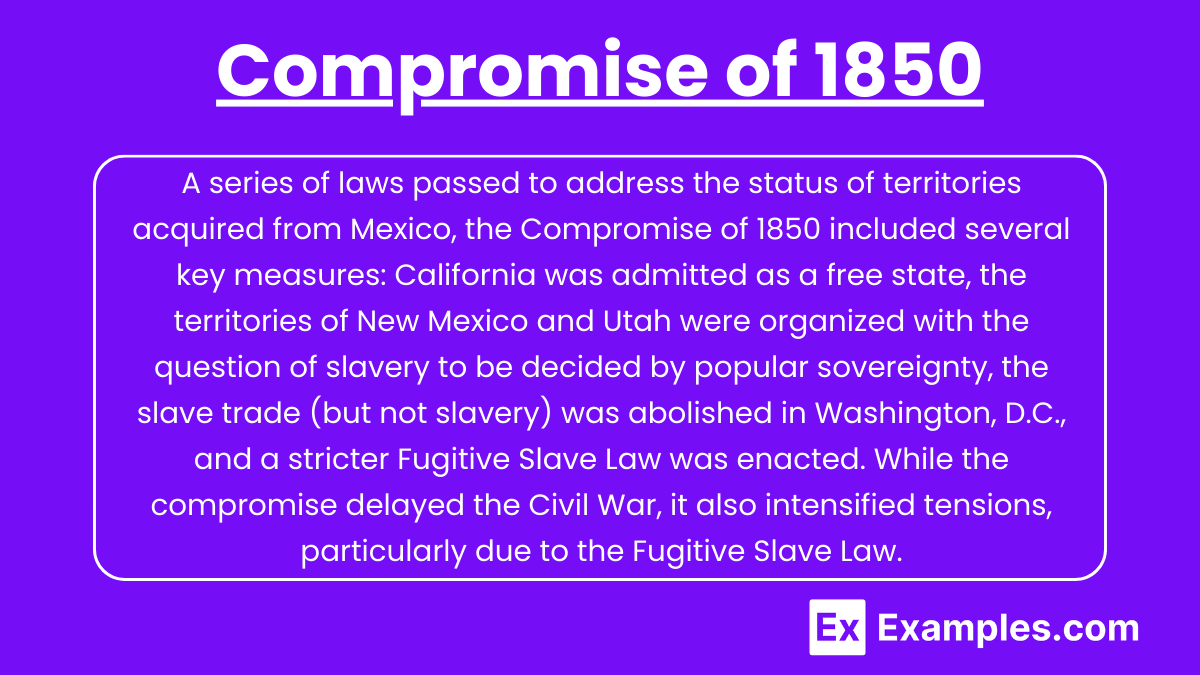
- A series of laws passed to address the status of territories acquired from Mexico, the Compromise of 1850 included several key measures: California was admitted as a free state, the territories of New Mexico and Utah were organized with the question of slavery to be decided by popular sovereignty, the slave trade (but not slavery) was abolished in Washington, D.C., and a stricter Fugitive Slave Law was enacted. While the compromise delayed the Civil War, it also intensified tensions, particularly due to the Fugitive Slave Law.
Kansas-Nebraska Act (1854)
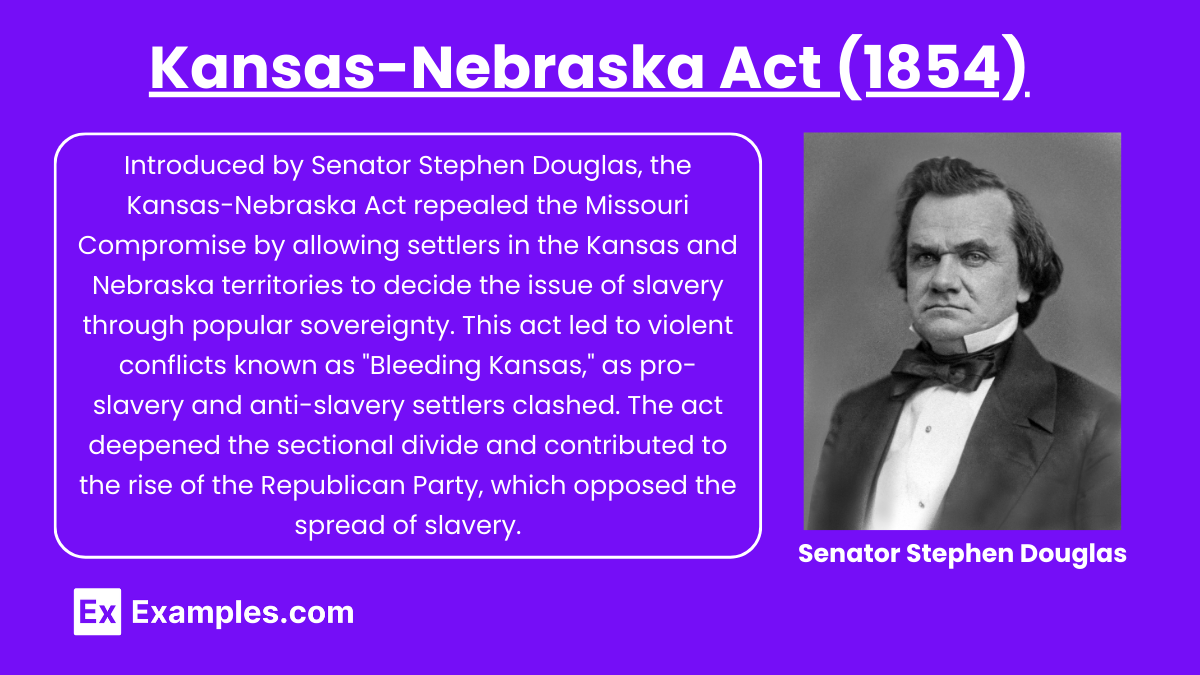
- Introduced by Senator Stephen Douglas, the Kansas-Nebraska Act repealed the Missouri Compromise by allowing settlers in the Kansas and Nebraska territories to decide the issue of slavery through popular sovereignty. This act led to violent conflicts known as “Bleeding Kansas,” as pro-slavery and anti-slavery settlers clashed. The act deepened the sectional divide and contributed to the rise of the Republican Party, which opposed the spread of slavery.
Dred Scott Decision (1857)
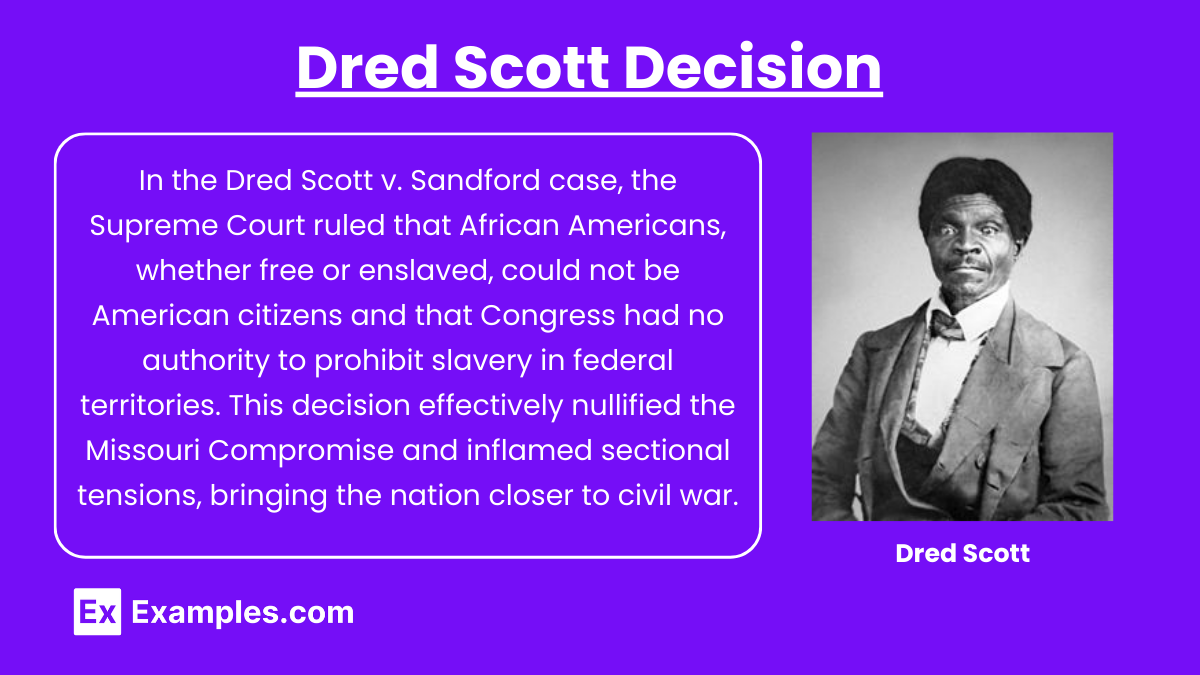
- In the Dred Scott v. Sandford case, the Supreme Court ruled that African Americans, whether free or enslaved, could not be American citizens and that Congress had no authority to prohibit slavery in federal territories. This decision effectively nullified the Missouri Compromise and inflamed sectional tensions, bringing the nation closer to civil war.
Consequences
The repeated failures of these legislative efforts to resolve conflicts over the spread of slavery underscored the irreconcilable differences between North and South. The inability to find a lasting solution ultimately led to the secession of Southern states and the outbreak of the Civil War in 1861.
Examples
- Missouri Compromise: Temporarily balanced power between slave and free states but highlighted the growing sectional divide.
- Wilmot Proviso: Demonstrated the deepening rift between North and South over the issue of slavery in newly acquired territories.
- Compromise of 1850: Delayed secession but inflamed tensions, particularly through the controversial Fugitive Slave Law.
- Kansas-Nebraska Act: Repealed the Missouri Compromise, leading to violent conflicts in Kansas and accelerating the nation’s path to civil war.
- Dred Scott Decision: Asserted that Congress could not prohibit slavery in the territories, exacerbating sectional tensions and invalidating previous compromises.
MCQs
- What was a primary provision of the Missouri Compromise of 1820?
- A) The abolition of slavery in the United States
- B) The admission of Missouri as a free state
- C) The establishment of the 36°30′ line as the dividing line between free and slave territories
- D) The ban on the importation of slaves
- Answer: C) The establishment of the 36°30′ line as the dividing line between free and slave territories
- Explanation: The Missouri Compromise admitted Missouri as a slave state and Maine as a free state while prohibiting slavery north of the 36°30′ latitude line, except in Missouri.
- Which legislation introduced the concept of popular sovereignty to decide the issue of slavery in new territories?
- A) Missouri Compromise
- B) Kansas-Nebraska Act
- C) Compromise of 1850
- D) Wilmot Proviso
- Answer: B) Kansas-Nebraska Act
- Explanation: The Kansas-Nebraska Act allowed settlers in Kansas and Nebraska to decide the issue of slavery by popular sovereignty, leading to violent conflicts known as “Bleeding Kansas.”
- The Dred Scott decision had what major impact on the spread of slavery?
- A) It upheld the Missouri Compromise.
- B) It declared that Congress could not ban slavery in federal territories.
- C) It banned slavery in all new states.
- D) It freed all enslaved people in federal territories.
- Answer: B) It declared that Congress could not ban slavery in federal territories.
- Explanation: The Dred Scott decision ruled that African Americans could not be citizens and that Congress had no authority to prohibit slavery in the territories, effectively nullifying the Missouri Compromise

